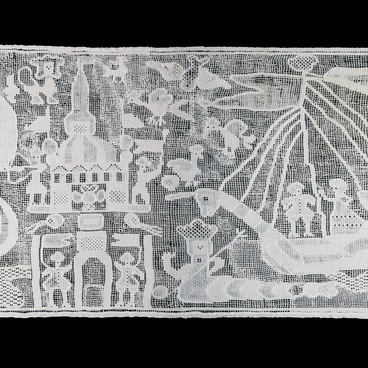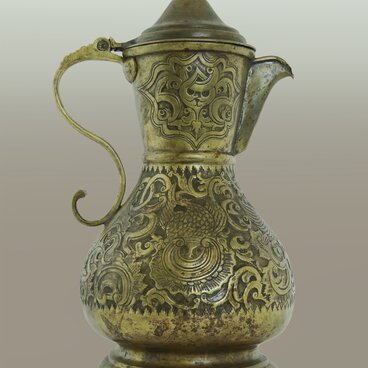In the town of Galich, Kostroma Governorate, both married and single women wore tall crest-shaped headdresses in the 18th and the first half of the 19th century. Such headdresses had a solid frame, and the front side was richly adorned with pieces of colored glass, sequins, colored foil, freshwater pearls or mother-of-pearl. These headdresses were part of the so-called sarafan urban complex of festive costume, which consisted of a sarafan sewn from factory-produced fabric, an elegant shirt with lace and tambour embroidery, and a traditional short jacket called a “dushegreya” or “shugai”.
At the beginning of the 19th century, sarafans and shugais were sewn from fabrics of different colors and patterns, which was associated with their high cost. But at the same time, it was very practical: a woman could assemble several options for a weekend outfit using a pair of sarafans and a pair of shugais. Young married women complemented their festive costume with a silk head veil or shawl, which they put on top of a pointed kokoshnik.
In the town Galich, Kostroma Governorate, the front side of the headdresses worn by single and married women was the same. It was the design of the headdress, however, that was different. The main difference was that, regardless of its shape, a kokoshnik was supposed to cover the woman’s hair. Maidens and brides could leave the top and back of their head uncovered to demonstrate one of the main attributes of girlhood — a braid.
These rules were followed in the town of Galich too. Local kokoshniks covered the back of the head and the hair with a piece made from expensive brocade, as decent women were supposed to do at the time.
The presented headdress features the technique called “Russian pearl embroidery” (“sazhenie po bely”), which has been known in Russia since the Early Middle Ages. The technique was used to decorate church vestments and utensils back in the 11th–13th centuries. In the 16th century, it began to be used in folk costume design. In the 18th and 19th centuries, Russian pearl embroidery was used in many regions of Russia to decorate festive female headdresses.
The Galich type of headdress was not for everyday use. Not every merchant family could afford it. These headdresses for women and maidens were commissioned and made by sublimely skillful craftsmen.
At the beginning of the 19th century, sarafans and shugais were sewn from fabrics of different colors and patterns, which was associated with their high cost. But at the same time, it was very practical: a woman could assemble several options for a weekend outfit using a pair of sarafans and a pair of shugais. Young married women complemented their festive costume with a silk head veil or shawl, which they put on top of a pointed kokoshnik.
In the town Galich, Kostroma Governorate, the front side of the headdresses worn by single and married women was the same. It was the design of the headdress, however, that was different. The main difference was that, regardless of its shape, a kokoshnik was supposed to cover the woman’s hair. Maidens and brides could leave the top and back of their head uncovered to demonstrate one of the main attributes of girlhood — a braid.
These rules were followed in the town of Galich too. Local kokoshniks covered the back of the head and the hair with a piece made from expensive brocade, as decent women were supposed to do at the time.
The presented headdress features the technique called “Russian pearl embroidery” (“sazhenie po bely”), which has been known in Russia since the Early Middle Ages. The technique was used to decorate church vestments and utensils back in the 11th–13th centuries. In the 16th century, it began to be used in folk costume design. In the 18th and 19th centuries, Russian pearl embroidery was used in many regions of Russia to decorate festive female headdresses.
The Galich type of headdress was not for everyday use. Not every merchant family could afford it. These headdresses for women and maidens were commissioned and made by sublimely skillful craftsmen.




